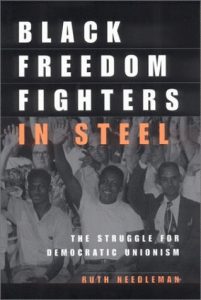Negro History Week was celebrated for the first time in 1926 during the second week in February. This month was chosen because Frederick Douglass and Abraham Lincoln celebrate their birthdays during this month. In 1976, Negro History Week became Black History Month and the rich history of African Americans began to receive special attention during the entire month of February.
As historians take a closer look at the many facets of black history in this country, they often find themselves documenting not only the struggle of oppressed people in this country, but how that struggle was part of a larger social and economic movement to improve the lives of the working class and their role within the American labor movement.
The UC Berkeley Labor Center Black Workers Resources page includes sections on African American Labor History Guides, Recommended Articles and Books, Films and Videos, Online Data Bases and links to websites.
The A. Philip Randolph Pullman Porter Museum is located in the Historic Pullman District in Chicago. Its mission is to promote, honor and celebrate the legacy of A. Philip Randolph and contributions made by African-Americans to America’s labor history. Their web site provides a number of excellent teaching resources including The Evolution & History of the Union.
Civil Rights and Labor: Joint Struggles for Justice by Corinne Geballe illuminates the similarities and differences between the two movements.
 Ruth Needleman’s Black Freedom Fighters in Steel: The Struggle for Democratic Unionism is the story of five black organizers, long-distance runners who were indispensable to building the steel workers union as well as the civil rights movement in northwest Indiana.
Ruth Needleman’s Black Freedom Fighters in Steel: The Struggle for Democratic Unionism is the story of five black organizers, long-distance runners who were indispensable to building the steel workers union as well as the civil rights movement in northwest Indiana.
Robert H. Ziegler analyzes the position of African American workers in the U.S. economy and social order over the past century and a half in his book For Jobs and Freedom: Race and Labor in America since 1865. This comprehensive study focuses on black workers’ efforts to gain equal rights in the workplace and deals extensively with organized labor’s complex and tumultuous relationship with African Americans. Highlighting the problems and opportunities that have characterized efforts to build biracial unions and forge a strong labor−civil rights political coalition, it is an authoritative treatment on the subject of race and labor in modern America.
The story of the 1939 interracial sharecroppers strike in Missouri is the subject of Oh Freedom After While, a 1999 California Newsreel DVD. One reviewer called it, “An epic tale of courage and perseverance, race and class, imagination and endurance.”
Another California Newsreel DVD (1996), A. Philip Randolph: For Jobs and Freedom takes viewers on a tour of 20th-century civil rights and labor history as it chronicles Randolph’s legendary efforts to build a more equitable society.
Miles of Smiles, a 1989 California Newsreel DVD, tells the story of the first black trade union – the Brotherhood of Sleeping Car Porters. It describes the 12 year struggle led by A. Philip Randolph to win the first contract ever negotiated with black workers.
A fourth California Newsreel DVD (1993), At The River I Stand is a 58-minute documentary that chronicles the connection between economic and civil rights, debates strategies for change, the demand for full inclusion of African Americans in American life and the fight for dignity for public employees and all working people. It highlights the 1968 Memphis sanitation workers strike and the assassination of Dr. Martin Luther King, Jr.
In his 1961 speech to the AFL-CIO convention, Dr. Martin Luther King, Jr. said, “The two most dynamic and cohesive liberal forces in the country are the labor movement and the Negro freedom movement.” The speech provides an excellent example of teaching with documents and for Document Based Questions (DBQs).
I am a Man: Dr. King and the Memphis Sanitation Strike, a 10 minute video produced by the American Federation of State, County and Municipal Employees (AFSCME) a reminder that the civil rights leader died while supporting a union.
The Coalition of Black Trade Unionists is an organization representing more than 50 different international and national unions with 50 chapters whose goal is to “build a national movement …to achieve economic, political and social justice for every American.” Its “Taking a Stand” section includes statements and videos by CBTU President Terry Melvin on a number of contemporary topics such as immigration, voting rights and others.
For more information about the American labor movement, visit The American Labor Studies Center.

